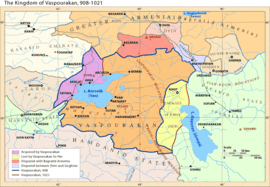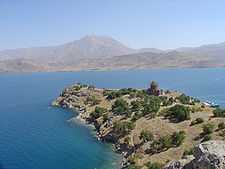Kingdom of Vaspurakan
| Kingdom of Vaspurakan Վասպուրական | |||||
| Kingdom | |||||
| |||||
 The Kingdom of Vaspurakan from 908 to 1021 | |||||
| Capital | Van | ||||
| Languages | Armenian | ||||
| Religion | Armenian Apostolic Church | ||||
| Government | Monarchy | ||||
| King | |||||
| - | 908-943 | Gagik I Artsruni | |||
| - | 1003-1021 | Seneqerim Artsruni | |||
| Historical era | Middle Ages | ||||
| - | Gagik I recognized as King of Armenia by Arab Caliph | 908 | |||
| - | Seneqerim Artsruni gave Vaspurakan to the Byzantine Empire | 1021 | |||
| Area | 40,870 km² (15,780 sq mi) | ||||
| Population | |||||
| - | est. | 1,000,000 | |||
| Density | 24.5 /km² (63.4 /sq mi) | ||||
| Currency | Solidus (coin), Hyperpyron | ||||
| Today part of | | ||||
Vaspurakan (also transliterated as Vasbouragan in Western Armenian; Armenian: Վասպուրական, (Vaspowrakan) meaning the "noble land" or "land of princes"[1]) was the first and biggest province of Greater Armenia, which later became an independent kingdom during the Middle Ages, centered around Lake Van. Located in what is now called eastern Turkey and northwestern Iran, the region is considered to be the cradle of Armenian civilization.[1]
History

During most of its history it was ruled by the Ardzruni dynasty, which first managed to create a principality in the area. At its greatest extent Vaspurakan comprised the lands between Lake Van and Lake Urmia (also known as Kaputan) in 908. During this time they were under the sovereignty of the Bagratouni Kingdom of Ani. In contrast to the Armenian Vaspourakan, Bagratouni Armenia continued to energetically fight invading forces. In 1021, the Saljuq Turks suffered a heavy defeat against an Armenian army, led by Vasak Pahlavouni, who died during the battle.[2]
Vaspurakan was elevated to kingdom status in 908. From 908, when Gagik I of Vaspurakan was recognized King of Armenia by an Arab caliph and at first was on their side, but soon he regretted and together with Ashot II defeated the Arabs. Soon he was recognized, as the King of Vaspurakan by Ashot II. In 1021 Seneqerim Artsruni gave Vaspurakan to the Byzantine Empire, receiving Sebasteia and its surroundings. Vaspurakan became the Byzantine province (thema) of Vasprakania or Media.[3] In about 1050 Vasprakania was merged with that of Taron, but was conquered by the Saljuq Turks between 1054-1056. In the 13th century part of Vaspurakan was liberated by Zakarids. But soon was conquered by Mongols, then by Ottoman Turks. Turks several times tried to kill Armenians in Vaspurakan, especially in Van. But Van's Armenian population always resisted, especially is notable Siege of Van of 1915, when the Ottoman forces attacked on Van during 1915's Armenian Genocide.
After the Byzantine annexation the dynasty continued with Derenik, son of Gurgen Khatchik, who became lord of Antzivaziq by 1004 and had two brothers: Gugik and Ashot. King Hovhannes-Seneqerim also had several children among them David, Atom, Abushal and Constantine. There is a legend that one of Seneqerim's daughter is thought to have married Mendo Alao, an Alan who lived in Lusitania. David had a daughter that married King Gagik II of Ani.
Another branch of the family appeared on the person of Khatchik the Great in 1040, who had three children: Hasan, Djendjluk and Ishkhanik. Hasan had a son called Abelgharib who had a daughter that married King David of Ani.[4]
The kingdom of Vaspurakan had no specific capital, the court moving as the king transferred his residence from place to place – Van, Ostan/Vostan (modern Gevaş), and so on.[5]
Rulers
Princes
- Hamazasp II, Prince (800–836). Married to a daughter of Ashot Msaker of the Bagratuni family.
- Ashot I Abulabus Artsruni, Prince (836–852). Son of Hamazasp II.
- Gurgen I Artsruni, Prince (852–853). Brother of Ashot I.
- Abu Djafar Artsruni, Prince (853–854). Probably brother of Ashot I.
- Gurgen II Artsruni of Mardastan, Prince. (854–857). Distant relative.
- Grigor-Derenik Artsruni, Prince (857–868). Married Sofia, daughter of Ashot I Bagratuni the Great, Prince of Armenia. Son of Ashot I Artsruni.
- Ashot I Abulabus Artsruni, Prince (868–874). Second term.
- Grigor-Derenik Artsruni, Prince (874–887). Second term.
- Gagik Abu Morvan Artsruni, regent for Grigor-Derenik's sons (887–896), then prince (896–898).
- Ashot-Sargis Artsruni, Prince (898–900). Son of Grigor-Derenik.
- Vaspurakan occupied by the Sajid emir Afshin (900).
- Safi, as governor of Van (900–901).
- Ashot-Sargis Artsruni (901–904). Reinstated.
- Gagik III (I) Artsruni, Lord of Rechtuniq (887–897). Prince of northwest Vaspurakan (904–908). King of Vaspurakan (908–943). Brother of Ashot-Sargis.
- Gurgen III Artsruni, Lord of Parskahayk (887–897). Prince of southeast Vaspurakan (904–925). Brother of Ashot-Sargis.
Kings
- Gagik I (III).
- Derenik-Ashot (Ashot III), King (943–953). Son of Gagik I.
- Abusahl-Hamazasp, King (953–972). Brother of Derenik-Ashot I.
- Ashot-Sahak (Ashot IV), King (972–983). Son of Abusahl-Hamazasp.
- Gurgen-Khachik (Gurgen IV), King (983–1003) and Lord of Antzevasiq. Brother of Ashot-Sahak.
- Seneqerim-Hovhannes, Brother of Ashot-Sahak, King (1003–1021) and lord of Rechtuniq. Also Lord of Sebasteia (1021). Brother of Gurgen Khatchik.
References
- ↑ 1.0 1.1 Hovannisian, Richard G. (1999). Armenian Van/Vaspurakan. Costa Mesa, California: Mazda Publishers.
- ↑ "The Liberated Jerusalem" by Tas, "In a war for your sake I am even ready to break down the gates to hell".
- ↑ Hewsen, Robert H. (2001). Armenia: a historical atlas. The University of Chicago Press. p. 126. ISBN 0-226-33228-4.
- ↑ http://medbib.com/Vaspurakan
- ↑ Hewsen, Robert H. (2001). Armenia: a historical atlas. The University of Chicago Press. p. 116. ISBN 0-226-33228-4.
«Վասպուրական» Հայրենակցական միություն http://vaspurakan.blogspot.com/
Bibliography
- Hovannisian, Richard G., ed. (2000) Armenian Van/Vaspurakan Historic Armenian Cities and Provinces Costa Mesa, California: Mazda Publishers OCLC 44774992
- Der Nersessian, Sirarpie. Armenia and the Byzantine Empire: a Brief Study of Armenian Art and Civilization. Cambridge: Harvard University Press. 1947.
| |||||||||||||||||||
Coordinates: 38°48′N 44°00′E / 38.8°N 44.0°E

